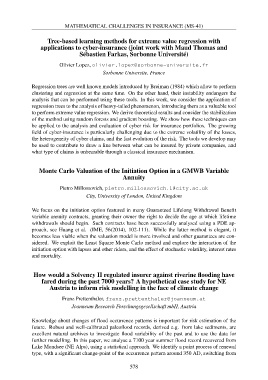Page 580 - 8th European Congress of Mathematics ∙ 20-26 June 2021 ∙ Portorož, Slovenia ∙ Book of Abstracts
P. 580
MATHEMATICAL CHALLENGES IN INSURANCE (MS-41)
Tree-based learning methods for extreme value regression with
applications to cyber-insurance (joint work with Maud Thomas and
Sébastien Farkas, Sorbonne Université)
Olivier Lopez, olivier.lopez@sorbonne-universite.fr
Sorbonne Universite, France
Regression trees are well known models introduced by Breiman (1984) which allow to perform
clustering and regression at the same time. On the other hand, their instability endangers the
analysis that can be performed using these tools. In this work, we consider the application of
regression trees to the analysis of heavy-tailed phenomenon, introducing them as a valuable tool
to perform extreme value regression. We derive theoretical results and consider the stabilization
of the method using random forests and gradient boosting. We show how these techniques can
be applied to the analysis and evaluation of cyber risk for insurance portfolios. The growing
field of cyber-insurance is particularly challenging due to the extreme volatility of the losses,
the heterogeneity of cyber claims, and the fast evolution of the risk. The tools we develop may
be used to contribute to draw a line between what can be insured by private companies, and
what type of claims is unbearable through a classical insurance mechanism.
Monte Carlo Valuation of the Initiation Option in a GMWB Variable
Annuity
Pietro Millossovich, pietro.millossovich.1@city.ac.uk
City, University of London, United Kingdom
We focus on the initiation option featured in many Guaranteed Lifelong Withdrawal Benefit
variable annuity contracts, granting their owner the right to decide the age at which lifetime
withdrawals should begin. Such contracts have been successfully analysed using a PDE ap-
proach, see Huang et al. (IME, 56(2014), 102-111). While the latter method is elegant, it
becomes less viable when the valuation model is more involved and other guarantees are con-
sidered. We exploit the Least Square Monte Carlo method and explore the interaction of the
initiation option with lapses and other riders, and the effect of stochastic volatility, interest rates
and mortality.
How would a Solvency II regulated insurer against riverine flooding have
fared during the past 7000 years? A hypothetical case study for NE
Austria to inform risk modelling in the face of climate change
Franz Prettenthaler, franz.prettenthaler@joanneum.at
Joanneum Research Forschungsgesellschaft mbH, Austria
Knowledge about changes of flood occurrence patterns is important for risk estimation of the
future. Robust and well-calibrated paleoflood records, derived e.g. from lake sediments, are
excellent natural archives to investigate flood variability of the past and to use the data for
further modelling. In this paper, we analyse a 7100 year summer flood record recovered from
Lake Mondsee (NE Alps), using a statistical approach. We identify a point process of renewal
type, with a significant change-point of the occurrence pattern around 350 AD, switching from
578
Tree-based learning methods for extreme value regression with
applications to cyber-insurance (joint work with Maud Thomas and
Sébastien Farkas, Sorbonne Université)
Olivier Lopez, olivier.lopez@sorbonne-universite.fr
Sorbonne Universite, France
Regression trees are well known models introduced by Breiman (1984) which allow to perform
clustering and regression at the same time. On the other hand, their instability endangers the
analysis that can be performed using these tools. In this work, we consider the application of
regression trees to the analysis of heavy-tailed phenomenon, introducing them as a valuable tool
to perform extreme value regression. We derive theoretical results and consider the stabilization
of the method using random forests and gradient boosting. We show how these techniques can
be applied to the analysis and evaluation of cyber risk for insurance portfolios. The growing
field of cyber-insurance is particularly challenging due to the extreme volatility of the losses,
the heterogeneity of cyber claims, and the fast evolution of the risk. The tools we develop may
be used to contribute to draw a line between what can be insured by private companies, and
what type of claims is unbearable through a classical insurance mechanism.
Monte Carlo Valuation of the Initiation Option in a GMWB Variable
Annuity
Pietro Millossovich, pietro.millossovich.1@city.ac.uk
City, University of London, United Kingdom
We focus on the initiation option featured in many Guaranteed Lifelong Withdrawal Benefit
variable annuity contracts, granting their owner the right to decide the age at which lifetime
withdrawals should begin. Such contracts have been successfully analysed using a PDE ap-
proach, see Huang et al. (IME, 56(2014), 102-111). While the latter method is elegant, it
becomes less viable when the valuation model is more involved and other guarantees are con-
sidered. We exploit the Least Square Monte Carlo method and explore the interaction of the
initiation option with lapses and other riders, and the effect of stochastic volatility, interest rates
and mortality.
How would a Solvency II regulated insurer against riverine flooding have
fared during the past 7000 years? A hypothetical case study for NE
Austria to inform risk modelling in the face of climate change
Franz Prettenthaler, franz.prettenthaler@joanneum.at
Joanneum Research Forschungsgesellschaft mbH, Austria
Knowledge about changes of flood occurrence patterns is important for risk estimation of the
future. Robust and well-calibrated paleoflood records, derived e.g. from lake sediments, are
excellent natural archives to investigate flood variability of the past and to use the data for
further modelling. In this paper, we analyse a 7100 year summer flood record recovered from
Lake Mondsee (NE Alps), using a statistical approach. We identify a point process of renewal
type, with a significant change-point of the occurrence pattern around 350 AD, switching from
578


